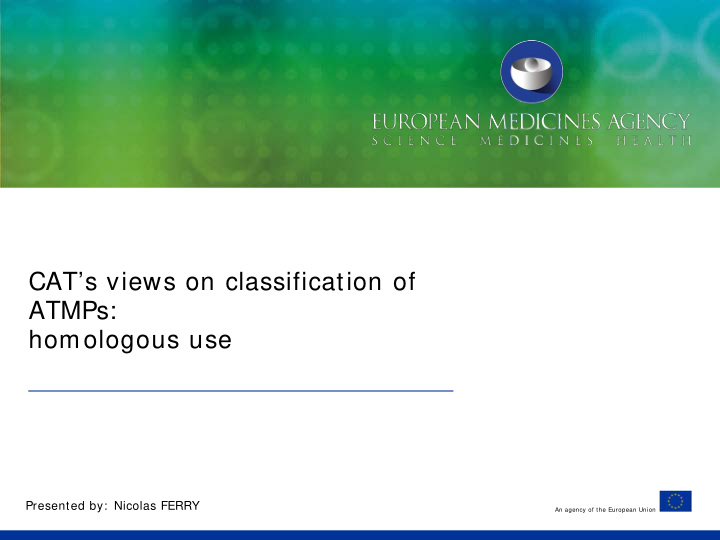



CAT’s views on classification of ATMPs: homologous use Presented by: Nicolas FERRY An agency of the European Union
European body of legislative texts The definition of ATMPs is laid down in Reg 1394/ 2007 modifying Dir 2001/ 83 Four Different types of ATMPs: 1 . Gene Therapy m edicinal products (defined in Annex I part IV of Dir 2001/ 83 amended by Dir 2009/ 120 ) 2 . Cell Therapy m edicinal products (defined in Annex I part IV of Dir 2001/ 83 amended by Dir 2009/ 120 ) 3 . Tissue engineered products 4 . Com bined ATMPs 1
Somatic Cell Therapy Medicinal Product ( defined in Annex I part IV of Dir 2001/ 83 amended by Dir 2009/ 120 ) Somatic cell therapy medicinal product means a biological medicinal product which has the following characteristics: (a)contains or consists of cells or tissues that have been subject to substantial manipulation so that biological characteristics, physiological functions or structural properties relevant for the intended clinical use have been altered, or of cells or tissues that are not intended to be used for the sam e essential function( s) in the recipient and the donor; (b)is presented as having properties for, or is used in or administered to human beings with a view to treating, preventing or diagnosing a disease through the pharmacological, immunological or metabolic action of its cells or tissues. 2
Homologous vs/ Non homologous use • Replacem ent vs new function: Organ iPSc transplantation 3
Homologous vs/ Non homologous use • Replacem ent vs new function: Organ BMT Pancreatic iPSc transplantation islest 4
Homologous vs/ Non homologous use • Replacem ent vs new function: Organ BMT Pancreatic Bone CD3 4 iPSc transplantation islest m arrow in in bone m yocardium healing 5
Homologous vs/ Non homologous use • cells or tissues that are not intended to be used for the sam e essential function( s) in the recipient and the donor The CAT classification is based on two different criteria: location and function Replacement on an original function may require the sam e anatom ical or histological environm ent, especially for epithelial cells 6
Homologous vs/ Non homologous use Reflection paper on classification of ATMPs EMA/ CAT/ 6 0 0 2 8 0 / 2 0 1 0 • Replacem ent: epithelium 7
Homologous vs/ Non homologous use Reflection paper on classification of ATMPs EMA/ CAT/ 6 0 0 2 8 0 / 2 0 1 0 • Cell dissociation m eans m odification of histology and function except w hen reim plantation in the sam e epithelium 8
Homologous vs/ Non homologous use • I slet preparation retains histological structure and function 9
Homologous vs/ Non homologous use • cells or tissues that are not intended to be used for the sam e essential function( s) in the recipient and the donor The CAT classification is based on two different criteria: location and function For m esenchym al cells , the function is not dependent on the histological location 10
Homologous vs/ Non homologous use • different function 11
Hematopoietic stem cells for bone marrow transplantation not manipulated for homologous use Apheresis Cell therapy unit Non substantial m anipulations Adm inistration Thaw ing and w ashing 12 CAT-DGTI-GSCN Workshop, Dresden, 11 September 2014
Stromal Vascular Fraction Autologous, non-manipulated lipoaspirate containing adipocytes and stromal vascular fraction intended to act as a natural autologous lipofiller W as classified as Not ATMP in 2 0 1 2 Could be considered now as somatic cell therapy if manufacturing process is considered a substantial manipulation 13
Homologous vs/ Non homologous use • New function • The cells or tissues have a different function in donor and recipient • CD3 4 + cells in heart m uscle • Bone m arrow cells for bone of joint healing 14
Homologous vs/ Non homologous use 15
Non homologous use Bone marrow-derived autologous CD34 cells Intended for improvement of heart function in patients with refractory angina and chronic myocardial ischemia Tissue-engineered product 22/ 03/ 2012 16
Non homologous use Autologous bone marrow cell aspirate in autologous plasma Intended for treatment of osteoarthrosis and osteochondral lesion Now considered as Tissue-engineered product 28/ 05/ 14 Form erly classified as non ATMP 17
CONCLUSION It is not always easy to define the « same essential function of a cell in a donor and a recipient » The CAT classification is based on existing scientific knowledge of cell biology. Classification may vary according to the evolution of science 18
Recommend
More recommend